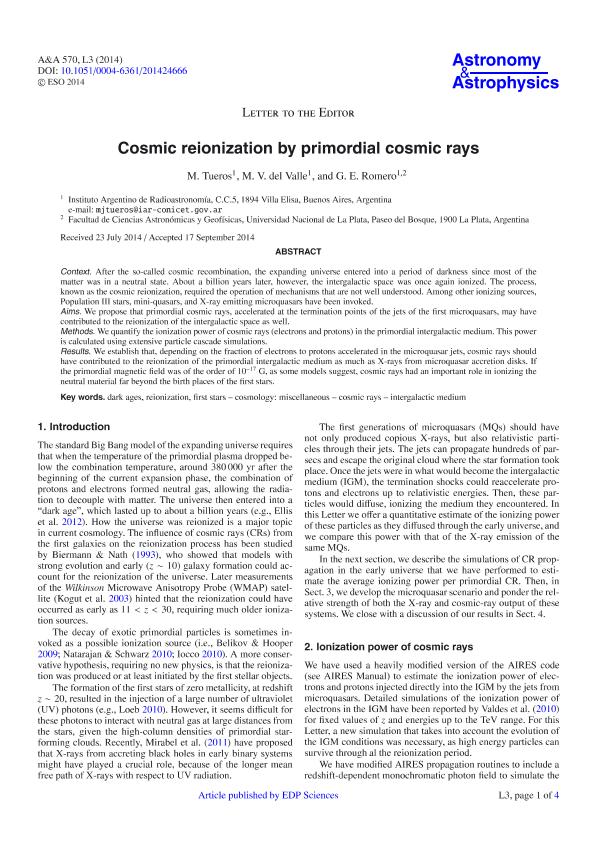Mostrar el registro sencillo del ítem
dc.contributor.author
Tueros, Matias Jorge

dc.contributor.author
del Valle, Maria Victoria

dc.contributor.author
Romero, Gustavo Esteban

dc.date.available
2016-05-24T20:12:48Z
dc.date.issued
2014-10
dc.identifier.citation
Tueros, Matias Jorge; del Valle, Maria Victoria; Romero, Gustavo Esteban; Cosmic reionization by primordial cosmic rays; EDP Sciences; Astronomy and Astrophysics; 570; L3; 10-2014; 1-4
dc.identifier.issn
0004-6361
dc.identifier.uri
http://hdl.handle.net/11336/5834
dc.description.abstract
Context. After the so-called cosmic recombination, the expanding universe entered into a period of darkness since most of the matter was in a neutral state. About a billion years later, however, the intergalactic space was once again ionized. The process, known as the cosmic reionization, required the operation of mechanisms that are not well understood. Among other ionizing sources, Population III stars, mini-quasars, and X-ray emitting microquasars have been invoked.
Aims. We propose that primordial cosmic rays, accelerated at the termination points of the jets of the first microquasars, may have contributed to the reionization of the intergalactic space as well.
Methods. We quantify the ionization power of cosmic rays (electrons and protons) in the primordial intergalactic medium. This power is calculated using extensive particle cascade simulations.
Results. We establish that, depending on the fraction of electrons to protons accelerated in the microquasar jets, cosmic rays should have contributed to the reionization of the primordial intergalactic medium as much as X-rays from microquasar accretion disks. If the primordial magnetic field was of the order of 10-17 G, as some models suggest, cosmic rays had an important role in ionizing the neutral material far beyond the birth places of the first stars.
dc.format
application/pdf
dc.language.iso
eng
dc.publisher
EDP Sciences

dc.rights
info:eu-repo/semantics/openAccess
dc.rights.uri
https://creativecommons.org/licenses/by/2.5/ar/
dc.subject
Dark Ages
dc.subject
Reionization
dc.subject
First Stars
dc.subject
Cosmology: Miscellaneous
dc.subject
Cosmic Rays
dc.subject
Intergalactic Medium
dc.subject.classification
Astronomía

dc.subject.classification
Ciencias Físicas

dc.subject.classification
CIENCIAS NATURALES Y EXACTAS

dc.title
Cosmic reionization by primordial cosmic rays
dc.type
info:eu-repo/semantics/article
dc.type
info:ar-repo/semantics/artículo
dc.type
info:eu-repo/semantics/publishedVersion
dc.date.updated
2016-02-05T14:54:48Z
dc.journal.volume
570
dc.journal.number
L3
dc.journal.pagination
1-4
dc.journal.pais
Francia

dc.journal.ciudad
Paris
dc.description.fil
Fil: Tueros, Matias Jorge. Consejo Nacional de Investigaciones Científicas y Técnicas. Centro Científico Tecnológico la Plata. Instituto Argentino de Radioastronomia (i); Argentina
dc.description.fil
Fil: del Valle, Maria Victoria. Consejo Nacional de Investigaciones Científicas y Técnicas. Centro Científico Tecnológico la Plata. Instituto Argentino de Radioastronomia (i); Argentina
dc.description.fil
Fil: Romero, Gustavo Esteban. Consejo Nacional de Investigaciones Científicas y Técnicas. Centro Científico Tecnológico La Plata. Instituto Argentino de Radioastronomia (i); Argentina. Universidad Nacional de la Plata. Facultad de Ciencias Astronómicas y Geofísicas; Argentina
dc.journal.title
Astronomy and Astrophysics

dc.relation.alternativeid
info:eu-repo/semantics/altIdentifier/url/http://www.aanda.org/articles/aa/abs/2014/10/aa24666-14/aa24666-14.html
dc.relation.alternativeid
info:eu-repo/semantics/altIdentifier/doi/http://dx.doi.org/10.1051/0004-6361/201424666
dc.relation.alternativeid
info:eu-repo/semantics/altIdentifier/doi/10.1051/0004-6361/201424666
dc.relation.alternativeid
info:eu-repo/semantics/altIdentifier/url/http://arxiv.org/abs/1409.6225v1
dc.relation.alternativeid
info:eu-repo/semantics/altIdentifier/arxiv/1409.6225v1
Archivos asociados
